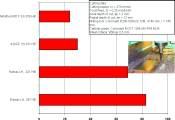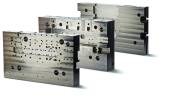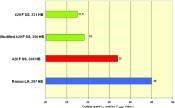Development of a New Mold Base Stainless Steel
Due to the intensive machining practices that must be performed on mold bases, if machining time and costs can be reduced, significant savings can be realized. A premuim free machining stainless holder steel has been developed that has optimized chemistry and processing, which lead to greatly improved machinability as well as other important properties.
For years, the focus of mold base development has been toward providing a steel with higher mechanical properties for the user of the mold bases; however, when these higher strength alloys are used, machining has not been optimized for the toolmaker, nor have his leadtimes or productivity. Several steel types have come into the market that lower the hardness of the steel, and hence improve machinability, but it is at the expense of other characteristics in the steel. A new mold base stainless steel has been developed that has an optimized alloy content that leads to greatly improved machinability as well as other important properties. Uniformity of hardness, and stability during machining have been optimized, while enhancing the corrosion resistance of the steel.
In order to judge the value of a new steel, it must be compared with the most commonly used materials on the market. In the case of corrosion resistant mold base steel, the materials to compare with are 420 free machining stainless steel, as well as DIN Numbers 1.2085 and 1.2099. This paper compares the newly developed stainless holder steel with the properties of these steels.
Today’s Material Demands
Due to the intensive machining practices that must be performed on mold bases, if machining time and costs can be reduced, significant savings can be realized.
Composition
There is a clear trend toward lower carbon content in prehardened material. This is valid both for corrosion resistant and non-corrosion resistant steel. The corrosion-resistant mold base materials are no exception (see Chart 1).
| Chart 1 | ||||||||
|
Grade
|
C
|
Si
|
Mn
|
Cr
|
Ni
|
Mo
|
S
|
N
|
| 420 F SS |
0.35
|
1.0 max
|
1.25 max
|
13.0
|
|
0.6 max
|
0.15 min
|
|
| New Premium Free Machining Stainless Holder Steel |
0.12
|
0.90
|
1.45
|
13.0
|
0.3
|
0.20
|
0.13
|
+
|
| Comparison chart. Chart courtesy of Bohler-Uddeholm. | ||||||||
This patented chemistry has a leaner alloy composition than a typical 420 free machining stainless, which will maintain a good corrosion resistance, but still give the desired machinability. Additions of nickel, molybdenum and nitrogen will also enhance the corrosion resistance. Tight control over process factors like ingot sizes and reduction ratio may cause differences in corrosion resistance, as the degree of chemical segregation may differ in the material and interfere with the corrosion resistance. Sulfur is present to aid in the machinability of the steel.
Even the toughness level can be of importance for the machinability. A tougher steel is normally more difficult to machine. In the premium free machining stainless holder steel the composition has been fine tuned in order to give the needed and wanted properties.
Hardness
Hardness level does have an effect on strength, indentation resistance and machinability. To optimize machinability while maintaining good mechanical strength, a hardness range was established to accomodate the needs of the toolmaker and end user.
For example, material suppliers offer higher hardness grades in the range of 320-350 HB (~1080-1200 MPa). This new stainless holder steel is in the range of 270-310 HB (~900-1050 MPa). The grade can be modified to provide higher hardness levels for key applications, while still having a machining advantage over alloy types.
Hardness range is important, but it is also as important for the mold base manufacturer and user that the hardness level is uniform throughout the entire dimension of the plate. The machinability can be reduced if areas with higher hardness are encountered during machining, or the material in lower hardness ranges can be too gummy for machining. Uneven hardness may also result in less stable material. Figure 1 is an example of hardness profiles measured in 180 mm thick (7.09 inches) of the new stainless holder steel. The hardness profile is very even, a difference of ~2 HRC in the 180 mm thick material. This uniformity will minimize gumminess in the material as it is drilled and tapped. It will also minimize hard spots in the steel from hardness variation.
Machining Properties
Machinability is the most important operation determining mold base making cost, but it is an extremely difficult property to test and rank in a trustworthy way. Different cutting tools and parameters will give different ranking of tool steel, so cutting parameters must be well defined. Even the toughness level can be of importance for machinability. A tougher steel is normally more difficult to machine.
House tests conducted in milling and drilling involved cavity milling with coated carbide inserts and drilling with uncoated high speed steel drills (see Figures 2 and 3).
Gundrilling tests were also performed. Gun drilling is a very difficult operation and it has a big influence on machining costs.
Parameters used are:
Machine: Willy Degen UTB 600H
Drill type: 8x950 mm, BRK K15 uncoated HSS
Depth: 350-400 mm
Speed: 60 m/min (2400 rpm)
Feed: 0.015 mm/turn (36 mm/min)
Coolant: Oil 62.5 bar
This premium stainless holder steel could be drilled 20m without the need for regrinding of the drill. When drilling in 420 F type at the the same hardness, there was a need for regrinding after a ~15 m drilled length. The test was stopped after a 20 m drilled length.
Stability
Other tests have shown excellent stability during milling and drilling. This material shows very little movement during machining, which minimizes the amount of shimming and rework that must be done to get the dimensions true to the print requirements. This material accomplishes this through the use of a higher tempering temperature and a controlled process route during its production, which minimizes the level of stresses found in the completed steel. The chemistry also minimizes the tendency towards higher stresses with an optimized microstructure.
Application Test Results
Further tests show that in all cases, the machining and stability results for this grade indicate that the stainless holder steel was comparable to or better than the easiest to machine holder stainless grades on the market. As compared to the higher hardness resulfurized grade, milling insert life was extended by three times, cutter widths were increased, and milling speeds were increased by 20 percent. Tests—including face milling, high-feed milling, finish milling, drilling, tapping and boring—all showed favorable results to the grades currently in use for holder stainless.
Welding
Welding is sometimes needed due to design changes or machining errors, and this will change the structure of the material. Factors to consider are: how to weld in order to minimize the effect and to use a welding rod adapted to the composition of the material to be welded.
The low alloy content of this steel makes the material easy to weld with less risk of hardening cracks during welding than in other 420 F alloy types. Small welds can be welded without the need for preheating. After welding the material, it is still recommended that the weld area be stress tempered in order to reduce the hardness of the weld and the stress level. A stainless steel 420 weld rod can be used.
Corrosion Resistance
The steel also must be able to demonstrate that it has sufficient corrosion resistance to atmospheric corrosion and other attacks common in injection and extrusion molding. An initial test of 14 days in a climate chamber of alternating temperature 8 hours at 35°C (93% humidity) and 8 hours at 15°C, indicated that the results of corrosion on the new premium stainless holder steel with nickel, nitrogen and molybdenum additions, were equal to if not better than the resulfurized stainless currently available (see Figure 4).
Should stress corrosion cracking become a factor in the threaded regions of the steel, if it is used for actual molding applications, its resistance to cracking up to 60 percent of its yield strength, which exceeds the capabilities of other resulfurized stainless alloys.
Summary
A new premium stainless holder steel was designed to optimize machinability and stability for the moldmaker, which translates into significant cost savings, reduced setup times and reduced leadtimes in the delivery of the mold base to the mold user. Other factors that have been optimized, such as weldability and corrosion resistance, will also mean that this steel can be used in other application areas than holders where these characteristics are also important.
Related Content
Leading Mold Manufacturers Share Best Practices for Improving Efficiency
Precise Tooling Solutions, X-Cell Tool and Mold, M&M Tool and Mold, Ameritech Die & Mold, and Cavalier Tool & Manufacturing, sit down for a fast-paced Q&A focused on strategies for improving efficiencies across their operations.
Read MoreConfronting the Mold Design Talent Drought
Recently, I reposted on LinkedIn the results of an informal survey we conducted, which revealed a shortage of skilled mold designers. It quickly gained a lot of traction. Given the response, I thought I'd summarize the feedback and keep the conversation going.
Read MoreMaking Mentoring Work | MMT Chat Part 2
Three of the TK Mold and Engineering team in Romeo, Michigan join me for Part 2 of this MMT Chat on mentorship by sharing how the AMBA’s Meet a Mentor Program works, lessons learned (and applied) and the way your shop can join this effort.
Read MoreHands-on Workshop Teaches Mold Maintenance Process
Intensive workshop teaches the process of mold maintenance to help put an end to the firefighting culture of many toolrooms.
Read MoreRead Next
Gas Permeable Mold Steel
The use of venting material in appropriate areas can eliminate gas buildup, reduce injection pressure, lower cycle times, gloss levels and substantially reduce scrap and reject rates.
Read MoreHow to Use Continuing Education to Remain Competitive in Moldmaking
Continued training helps moldmakers make tooling decisions and properly use the latest cutting tool to efficiently machine high-quality molds.
Read MoreHow to Use Strategic Planning Tools, Data to Manage the Human Side of Business
Q&A with Marion Wells, MMT EAB member and founder of Human Asset Management.
Read More.jpg;maxWidth=970;quality=90)


















.jpg;maxWidth=300;quality=90)







